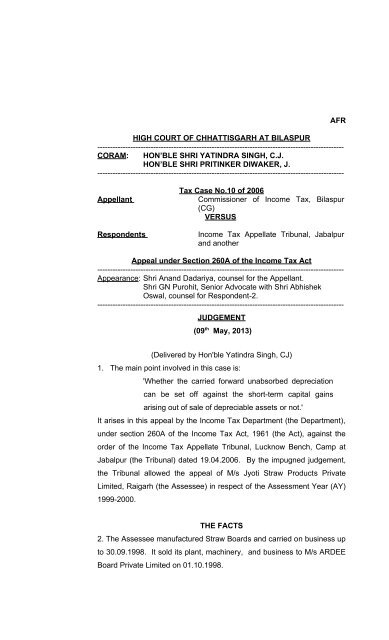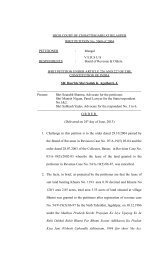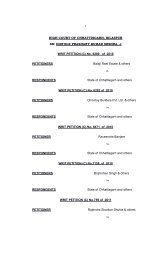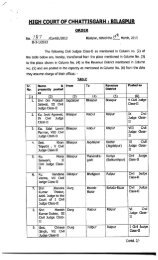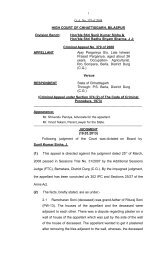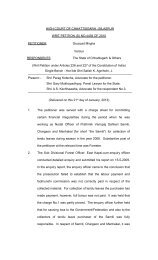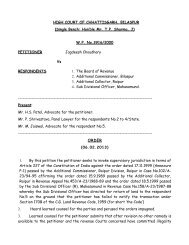HIGH COURT OF JUDICATURE CHHATTISGARH : BILASPUR
HIGH COURT OF JUDICATURE CHHATTISGARH : BILASPUR
HIGH COURT OF JUDICATURE CHHATTISGARH : BILASPUR
You also want an ePaper? Increase the reach of your titles
YUMPU automatically turns print PDFs into web optimized ePapers that Google loves.
AFR<strong>HIGH</strong> <strong>COURT</strong> <strong>OF</strong> <strong>CHHATTISGARH</strong> AT <strong>BILASPUR</strong>-------------------------------------------------------------------------------------------------CORAM: HON’BLE SHRI YATINDRA SINGH, C.J.HON’BLE SHRI PRITINKER DIWAKER, J.-------------------------------------------------------------------------------------------------AppellantRespondentsTax Case No.10 of 2006Commissioner of Income Tax, Bilaspur(CG)VERSUSIncome Tax Appellate Tribunal, Jabalpurand anotherAppeal under Section 260A of the Income Tax Act-------------------------------------------------------------------------------------------------Appearance: Shri Anand Dadariya, counsel for the Appellant.Shri GN Purohit, Senior Advocate with Shri AbhishekOswal, counsel for Respondent-2.-------------------------------------------------------------------------------------------------JUDGEMENT(09 th May, 2013)(Delivered by Hon'ble Yatindra Singh, CJ)1. The main point involved in this case is:'Whether the carried forward unabsorbed depreciationcan be set off against the short-term capital gainsarising out of sale of depreciable assets or not.'It arises in this appeal by the Income Tax Department (the Department),under section 260A of the Income Tax Act, 1961 (the Act), against theorder of the Income Tax Appellate Tribunal, Lucknow Bench, Camp atJabalpur (the Tribunal) dated 19.04.2006. By the impugned judgement,the Tribunal allowed the appeal of M/s Jyoti Straw Products PrivateLimited, Raigarh (the Assessee) in respect of the Assessment Year (AY)1999-2000.THE FACTS2. The Assessee manufactured Straw Boards and carried on business upto 30.09.1998. It sold its plant, machinery, and business to M/s ARDEEBoard Private Limited on 01.10.1998.
3• Secondly, carried forward unabsorbed depreciation could not beset off against the short-term capital gains on sale of depreciableassets.8. The Assessee filed the second appeal before the Tribunal. It wasallowed on 19.04.2006. The Tribunal held that:• Under the first proviso to section 32(2)(iii), the condition was tocarry on business in the previous year. It was not necessary thatbusiness should be carried on for the entire year;• The short-term capital gain/ loss on sale of depreciable assetswas to be dealt with under the head of 'profit and gains ofbusiness or profession' in view of the decision in JK ChemicalsLimited Vs ACIT (ITA 8618/Bombay/89) given by the BombayBench of the Tribunal; and• The unabsorbed depreciation could be set off against the shorttermcapital gains on sale of depreciable assets.Hence, the present appeal by the Department.POINTS FOR DETERMINATION9. We have heard counsel for the parties. This appeal was admitted on02.02.2010 on the following substantial questions of law:• 'Whether on the facts and in the circumstances of the case, theTribunal was justified in holding that the short-term capital gainsarising on sale of plant & machinery and other assets has to beassessed under the head “business income” and not under thehead “capital gains”?• Whether on the facts and in the circumstances of the case, theTribunal was justified in allowing the claim of set-off of unabsorbeddepreciation allowance of earlier years against the short-termcapital gains of the current year by omitting to take cognizance ofthe provisions of Section 32 (2) (iii) (a) which stipulates such setoffonly against profits and gains, if any, of any business ofprofession carried on by the assessee?'
4However, the main question is as we have indicated in our openingparagraph.10. On the basis of the aforesaid questions and on the arguments of thecounsel for the parties, the following points arise for determination in theappeal:(i) Whether the benefit of set off can be availed under section 32(2)(iii) of the Act, even if the business was not carried on for theentire year;(ii) Whether the carried forward unabsorbed depreciation can be setoff only against the profits and gains of any business or professioncarried on by the Assessee or against income under any otherhead;(iii) Whether the short-term capital gain on the sale of depreciableassets is an income under the head of 'profits and gains of anybusiness or profession' or not;1 st POINT: NOT NECESSARY TO CARRY ON BUSINESS FORENTIRE YEAR11. The counsel for the Department submitted that:• In view of first proviso to section 32(2)(iii), the carried forwardunabsorbed depreciation could be set off only if business wascarried on for the entire previous year;• In this case, business was not carried on for the entire year;• The Assessee was not entitled to set off its carried forwardunabsorbed depreciation.12. In the relevant assessment year 1999-2000, the first proviso tosection 32(2)(iii) of the Act was as follows:'...Provided that the business or profession for which the allowancewas originally computed continued to be carried on by him in theprevious year relevant for that assessment year....'
5It was later on deleted by the Finance Act of 2000 with effect from01.04.2001.13. The provision mandates that business or profession for which theallowance was originally computed should be continued by the Assesseein the previous year. It nowhere mandates that business should continuefor the entire year. In the present case, the Assessee did continuebusiness up to 30.09.1998.14. The counsel for the Department would like us to read the words'continued to be carried on by him in the previous year' as 'continuedto be carried on by him for the entire previous year'. He wishes us toread the word 'entire', which is not there.15. If the intention of the legislature was, as was submitted by thecounsel for the Department then, there was no difficulty in using the wordin the 'entire previous year' in place of just 'previous year'. Thelegislature by not using the word 'entire' clearly showed its intention that itwas not necessary that the business should be carried on for the entireyear.16. It is settled law that 'the intention of the Legislature is primarily to begathered from the language used, which means that attention should bepaid to what has been said as also to what has not been said. 1 As aconsequence a construction which requires for its support addition orsubstitution of words or which results in rejection of words as1Gwalior Rayon Silk Mfg. (Wvg.) Co. Ltd. v. Custodian of Vested Forests, AIR1990 SC 1747 = 1990 (2) JT 130 = 1990 Supp SCC 785; Mohammad Alikhanv. Commissioner of Wealth Tax, AIR 1997 SC 1165 :=1997 (3) SCC 511;Institute of Chartered Accountants of India v. Price Waterhouse, AIR 1998 SC74 = (1997) 6 SCC 312; Dental Council of India v. Hari Prakash, AIR 2001 SC3303 = (2001) 8 SCC 61; JP Bansal v. State of Rajasthan, AIR 2003 SC 1405 =2003 AIR SCW 1848 = (2003) 5 SCC 134; Dental Council of India v. HariPrashad, AIR 2001 SC 3303 = (2001) 8 SCC 61; Illachi Devi v. Jain SocietyProtection of Orphans , (2003) 8 SCC 413; State of Jharkhand v. Govind Singh,AIR 2005 SC 294; Commissioner of Income Tax, Kerala v. Tata Agencies,(2007) 6 SCC 429; Nagar Palika Nigam v. Krishi Upaj Mandi Samiti, AIR 2009SC 187 = (2008) 12 SCC 364.
6meaningless has to be avoided 2 (see 'Principles of StatutoryInterpretation' by Justice GP Singh, 12 th edition, page 64).17. In our opinion,• An assessee is entitled to claim set off even if business wascarried on for the part of the year;• The proviso does not prevent the Assessee from taking advantageof section 32(2)(iii), if the other conditions are satisfied.2 nd POINT: ONLY AGAINST PR<strong>OF</strong>IT AND GAINS <strong>OF</strong> BUSINESS ORPR<strong>OF</strong>ESSION18. Chapter IV of the Act is titled 'Computation of total income'. Itprovides how income of an Assessee for purposes of the Act is to becomputed. Section 14 is in this chapter. It is titled 'Heads of Income'. Itprovides different heads under which total income is to be computed.19. Section 14 provides five kinds of heads namely, 'A.—Salaries','C.—Income from house property', 'D.—Profits and gains of business or,profession', 'E.—Capital gains' and 'F.—Income from other sources'.Initially, the Act provided one more head, namely, 'B.—Interest onsecurities' but it was later deleted by Finance Act, 1988 wef 01.04.1989.20. Chapter IV is further subdivided into different sub-chapters 'A', 'C','D', 'E' and 'F'. Each sub-chapter provides different sources of incomeunder a head.2Shyam Kishori Devi v. Patna Municipal Corporation, AIR 1966 SC 1678 =1966 (3) SCR 466; Management, Shahdara (Delhi) Saharanpur Light Rly. Co.Ltd. v. SS Rly. Workers Union, AIR 1969 SC 513 = (1969) 2 SCR 131; S.Narayanaswami v. G. Panneerselvam, AIR 1972 SC 2284 = (1972) 3 SCC 717;Union of India v. Sankalchand, AIR 1977 SC 2328 = (1977) 4 SCC 193; ARAntuley v. Ramdas Srinivas Nayak, AIR 1984 SC 718 = (1984) 2 SCC 500;Mohammad Alikhan v. Commissioner of Wealth Tax, AIR 1997 SC 1165 =1997 (3) SCC 511; Institute of Chartered Accountants of India v. PriceWaterhouse, AIR 1998 SC 74 = (1997) 6 SCC 312; State of Maharashtra v.Nanded Prabhani Operator Sangh, AIR 2000 SC 725 = (2000) 2 SCC 69;Grasim Industries Ltd. Collector of Customs, AIR 2002 SC1706 := (2002) 4 SCC297; JP Bansal v. State of Rajasthan, AIR 2003 SC 1405= 2003 AIR SCW 1848= (2003) 5 SCC 134; State of Jharkhand v. Govind Singh, AIR 2005 SC 294 .
721. In calculating the income under a head, certain deductions can alsobe made. These deductions are provided in that particular head itself.Normally, loss under one head can be set off only against the profit inthat head, unless it is so provided under any provision of the Act.22. Sub-chapter D of chapter IV is titled 'D.—Profits and gains ofbusiness or profession'. Section 32 is in this sub-chapter. It is titled'Depreciation' and provides deductions on account of depreciation.23. Under the Act, income is taxed regardless diminishing value of theassets except, allowance, in form of depreciation for some assets.Generally, depreciation represents the diminution in value of a capitalasset, when applied to the purpose of making profit or gain and it is alegitimate deduction in determining the true profits (see below forcitations) 3 .24. In the relevant AY, sub-section (1) of section 32 {Section 32(1)}provided how depreciation was to be calculated for different assets andits set off against profits and gains of that business.25. Sub-section 2 of section 32 {Section 32(2)} (see Appendix-1)explained the words 'unabsorbed depreciation'. It was that part ofallowance under clause (ii) of sub-section (1) of section 32 {section 32(1)(ii)} {see Endnote-1 for clarification on section 32(1)(ii)} that could not begiven full effect to in any previous year owing to there being no profits orgains in that previous year or it being less than the allowance.26. Section 32(2)(i)(ii) provided setting of current unabsorbeddepreciation. Section 32(2)(i) provided that it could be set off against3Bandiani Vs CIT 105 ITR 642, 647-49(SC); CIT Vs Gujrat SWC 104 ITR 1;Nippon Vs CIT 116 ITR 231 ; CIT Vs Bombay STC 118 ITR 399 ; Vegetable oilMfg Vs CIT 147 ITR 544; CIT Vs Raipur Pallottine 180 ITR 579; CIT Vs VazirSultan 184 ITR 64, CIT Vs Anand 244 ITR 192 (SC); CIT Vs Indin Jute MillAssn. 134 ITR 68; Indian Leaf Tobacco Vs CIT 137 ITR 827 ); CIT Vs Societyof Sisters of St. Anne 146 ITR 28 .
8profits and gains, if any, of any business or profession carried on by theassessee and in case it could not be done then it could be set off fromthe income of the Assessee under any other head under section 32(2)(ii)of the Act. The unabsorbed depreciation allowance that could not be soset off, was to be carried forward for the next eight years under section32(2)(iii)(b).27. Section 32(2)(iii) provided setting off of carried forward unabsorbeddepreciation allowance but a reading of section 32(2)(iii) in contrast tosection 32(2)(i) and (ii) indicates that it could be set off only against theprofits and gains of any business or profession.28. The counsel for the Assessee submitted that under section 32(2)(iii)of the Act carried forward unabsorbed depreciation allowance could beset off, not only against the profits and gains of any business orprofession of the Assessee, but also against the income from any otherhead.29. In order to support the aforesaid submission, the counsel for theAssessee brought to our notice, the three decisions of the Madras HighCourt (see below for citations) 4 and decisions of the different Benches ofthe Tribunal (see below for citations) 5 . In these cases, the speech of theFinance Minister while passing the Finance Act-2 of 1996 (see below for4Commissioner of Income Tax vs RPIL Signalling Systems Limited {(2010) 328ITR 283 (Mad); and Commissioner of Income Tax vs S & S Power SwitchgearLimited {(2008) 218 CTR (Mad) 701 = (2009) 318 ITR 187 = (2008) 5 DTR289 }; and Commissioner of Income Tax vs Pioneer Asia Packing (P) Limited{(2008) 214 CTR (Mad) 202 = (2009) 310 ITR 198 = (2008) 170 Taxman 127 =(2008) 1 DTR 1935Digital Electronics Limited Vs Additional Commissioner of Income Tax {(2011)135 TTJ (Mumbai) 419 = (2011) 49 DTR 484} and Deputy Commissioner ofIncome Tax vs Times Guaranty Limited {(2010) 131 TTJ (Mumbai) (SB) 257 =(2010) 40 SOT 14 = (2010) 41 DTR 193 = (2010) 4 ITR 210
9the relevant part of the speech) 6 was relied upon to uphold thissubmission.30. The speech does support the submission of the counsel for theAssessee but section 32(2) is otherwise. The question is, can thespeech of the Finance Minister be taken into account, while interpreting aclear and unambiguous section.31. House of Lords in Pepper v. Hart {(1993)1 All ER 42} (the Peppercase) observed:'Reference to parliamentary material should be permitted as anaid to the construction of legislation which is ambiguous orobscure or the literal meaning of which leads to absurdity. Evenin such cases references in court to parliamentary materialshould only be permitted where such material clearly disclosesthe mischief aided at or the legislative intention lying behind theambiguous or obscure words. In the case of statements madein Parliament, as at present advised, I cannot foresee that anystatement other than the statement of the minister or otherpromoter of the Bill is likely to meet these criteria.'32. Our Supreme Court considered the Pepper case in P.V. NarsimhaRao v. State (AIR 1998 SC 2120) (the Narasimha case). The question inthis case was, whether a member of Parliament was a public servant6The relevant part of the speech of the Finance Minister is as follows:'Clause 11 of the Bill seeks to amend s.32 of the IT Act, 1961relating to depreciation. During the course of discussion on theGeneral Budget, a number of Hon'ble members have expressedtheir apprehension that the proposed amendment limiting carryforward of unabsorbed depreciation to 8 years will adversely affectthe growth of industry. Similar apprehensions have been raised in alarger number of post-budget memoranda. I would like to allay thesefears. 'The proposed amendment is only prospective inasmuch asthe cumulative unabsorbed depreciation brought forward as on 1 stApril, 1997, can still be set off against taxable business profits orincome under any other head for the asst. yr. 1997-98 and sevensubsequent assessment years. Therefore, the proposed change willhave effect only after 8 years and there is no cause for immediateconcern about its likely impact on industry.'
10within the definition of section 2(c)(viii) of the Prevention of CorruptionAct, 1998.33. In the Narsimha case, the Supreme Court declined to admit theminister's speech in Parliament for finding the intention of Parliament inenacting that section as according to the court the provision wasunambiguous and the minister's speech was also equivocal.34. The intention of the legislature is to be seen from the use of thewords in the statute. The question is not what might be intended butwhat has been said. This can be best inferred by the language of thestatute; it is the language of the statute that determines the legislativeintention (see below for citations) 7 .35. Justice Holmes once remarked 8 ,'I do not care what their intention was, I only want to knowwhat the words mean?'And at the other time,'We do not inquire what the legislation meant; we ask only whatthe statute means.'In one of his decisions 9 , he observed,7New Piece Goods Bazar Co. Ltd. v CIT, Bombay, AIR 1950 SC 165;Ramkrishan v State of Delhi, AIR 1956 SC 476; Kanailal Sur v. ParamnidhiSadhukhan, AIR 1957 SC 907; Ramkrishna Ram Nath v. Janpad Sabha, AIR1962 SC 1073; Controller of Estate Duty v. Kantilal Tikamlal, AIR 1976 SC 1935= 1977 SCC (Tax) 90 ; Union of India v. Sankalchand Himmatlal Sheth, AIR1977 SC 2328 = (1977) 4 SCC 193; Chief Justice of Andhra Pradesh v. LVADikshitulu, AIR 1979 SC 193 = (1979) 2 SCC 340; Om Prakash Gupta v.Digvijendrapal Gupta, AIR 1982 SC 1230 = (1982) 2 SCC 61; Babaji KondajiGarod v. Nasik Merchants Co-operative Bank Ltd. AIR 1984 SC 192 = (1984) 2SCC 50; Doypack System Pvt. Ltd. v. Union Of India, AIR 1988 SC 782 = 1988(2) SCC 299; Member Secretary, Andhra Pradesh State Board for Preventionand Control of Water Pollution v. Andhra Pradesh Rayons Ltd, AIR 1989 SC611 = 1989 (1) SCC 44; Keshavji Ravji and Co. v. Commissioner of IncomeTax, AIR 1991 SC 1806 = (1990) 2 SCC 231; Bola v. BD Sardana, AIR 1997 SC3127 = (1997) 8 SCC 522; Unique Butyle Tube Industries (P) Ltd. V UPFinancial Corporation, (2003) 2 SCC 455.8From the book 'Philosophical Foundation of Language in the Law' published byOxford University press, edited by Andrei Marmor and Scott Soames- Page 7.9Northern Securities Co. Vs US -193 US 197
11'[A]t times judges need for their work the training ofeconomists or statesmen, and must act in view of theirforesight of consequences, yet when their task is to interpretand apply the words of a statute, their function is merelyacademic to begin with—to read English intelligently ...'36. In our opinion, the speech of a minister cannot be taken into accountto interpret a provision that is clear and unambiguous. The question,whether it can be taken into account to interpret a provision that isambiguous, may be considered in an appropriate case.37. In section 32(2) (ii), any other income is specifically mentioned, but itis not so mentioned in section 32(2)(iii). This clearly shows the intentionof the legislature that the carried forward unabsorbed depreciationallowance cannot be set off against income other than the income fromprofits and gains of business or profession.38. In the present case, there is no ambiguity in section 32(2)(iii) of theAct. The speech of the Finance Minister cannot be taken into account tointerpret it. With due respects to the judges of the Madras High Courtand members of different benches of the Tribunal, we disagree withthem.39. 'Kanga, Palkhivala and Vyas: The Law and Practice of Income Tax'(9 th Edition page 732) sums up the law of unabsorbed depreciation asfollows:'From assessment year 1997-98, there was a drasticamendment in the scheme of carry-forward and set-off ofunabsorbed depreciation by substitution of a new subsection(2)in section 32. It was put, in many respects, at parwith business loss. In comparison and contradistinction to the
12earlier provisions, the features of the new provisions are asunder:(i) Unlike before, there is no legal fiction to deem carriedforward unabsorbed depreciation to be part of currentdepreciation;(ii) Unabsorbed depreciation is allowed to be carriedforward for set-off for eight years succeeding the yearto which such depreciation relates, and notindefinitely like before;(iii) The carried forward unabsorbed depreciation can beset-off against the profits and gains, if any, of anybusiness or profession carried on by the assesseeduring that year, and not against other non-businessincome;(iv) The business or profession to which the unabsorbeddepreciation relates should be continued to be carriedon in the year of set-off (first proviso to s32(2) deletedfrom assessment year 2001-02).'For our discussion, the law as summarised at serial number (iii) isrelevant and states the same thing as we have held.40. In our opinion, the carried forward unabsorbed depreciation undersection 32(2)(iii) of the Act could be set off in the relevant AY only againstany profit and gains of any business or profession carried on by theAssessee and not against any other non-business income. However, thequestion remains, whether the short-term capital gains on sale ofdepreciable assets can be treated as income from profits and gains ofbusiness or profession or not. This is being dealt with, in the third point.3 rd POINT: SHORT TERM CAPITAL GAIN IS NON-BUSINESS INCOME41. The counsel for the Assessee has brought to our notice sub-section(2) of section 41 {section 41(2)} (see Appendix-2) and submits that:
13(i) Short term capital gain from sale of depreciable assets is dealtunder section 41(2) of the Act. Under this section, it is to betreated as income from business or profession;(ii) The Assessee is entitled to set off its carried forward unabsorbeddepreciation from short-term capital gains arising out of sale ofdepreciable assets as it is treated as business income;(iii) In any case, the purpose of putting business assets in one blockwas to facilitate filing of tax return and tax computation. The legalfiction treating them short-term capital was for this purpose only.The legal fiction cannot be further extended.1 st & 2 nd Submissions: Section 41(2) is not Applicable42. Section 2 of the Act is titled 'Definitions'. It defines different words asfollows:• Section 2(14) defines the words 'capital asset';• Section 2(42A) defines the words 'short term capital asset';• Section 2(42B) defines the words 'short term capital gain;• Section 2(11) defines the words 'block of assets'. It includestangible assets like building, machinery, plant, or furniture as wellas intangible asset that includes intellectual property rights orbusiness rights in respect of which the same percentage ofdepreciation is prescribed.Nevertheless, section 2 of the Act neither defines the words 'depreciableassets' nor the words 'short term capital gains arising out of the sale ofdepreciable assets'.43. Section 50 of the Act (see Appendix-3) is titled 'Special provision forcomputation of capital gains in case of depreciable assets'. It explainsshort time capital gains arising out of the sale of depreciable assets. It isbecause of this provision that the Assessee had short term capital gains.The question is whether this can be treated as business income or not.44. Section 41 is titled 'Profits chargeable to tax' and is under subchapter'D—Profits and gains of business or profession' of Chapter-IV of
14the Act. Sub-section (2) of section 41 {section 41(2)} of the Act providesthat in some cases of sale of buildings, machinery, plant or furniture, ifthe money payable exceeds the written down value of those assets, thenit would be treated as income of the business of the previous year.45. In case, section 41(2) is applicable to the Assessee, then the shorttermcapital gains in this case would be business income from whichcarried forward unabsorbed depreciation could be set off. But thequestion is, does it apply in the present case ?46. Sub-clauses (a) and (b) of section 41(2) lay down necessaryconditions of its application. Section 41(2)(b) provides that it applies tothe sale of that building, machinery, plant or furniture, in respect of which,depreciation is claimed under clause (i) of sub-section (1) of section 32{section 32(1)(i)} of the Act. But did the Assessee claim depreciationunder section 32(1)(i) of the Act?47. Section 41(2) was substituted in the Act by Finance Act 2of 1998 with effect from 01.04.1998. At that time, section 32(1)(i) (seeAppendix-4) related to depreciation claimed by an undertaking engagedin generation or generation and distribution of power (for clarificationplease see Endnote-1), that is to say, section 41(2) is confined to theassets of an undertaking engaged in generation or generation anddistribution of power.48. The Assessee was not engaged in generation or generation anddistribution of power. It was manufacturing straw boards. In the presentcase, depreciation was not claimed under section 32(1)(i) of Act, but itwas claimed under section 32(1)(ii) of the Act. Section 32(1)(i) as well assection 41(2) of the Act is not applicable here.3 rd Submissions: Full effect is to be given to Legal Fiction49. Concept of 'block of asset' was introduced by the Taxation Laws(Amendment & Miscellaneous Provisions) Amendments Act 1986 wef
1501.04.1988. It broadly included tangible assets. It was amended byFinance (number 2) Act, 1998 wef 01.04.1999 to include intangibleassets as well. This concept was basically introduced to simplify thereturn filing and tax computations.50. Section 50 of the Act creates legal fiction. It deems certain income tobe short-term capital gains. Should it be limited only for the purpose offiling of tax return and computation of income or should we give full effectto it.51. Lord Asquith in 'In East End Dwelling Co. Ltd. v. Finsbury BoroughCouncil (1951) 2 All ER 587 (the Finsbury case) explained:'If you are bidden to treat an imaginary state of affairs asreal, you must surely, unless prohibited from doing so,also imagine as real the consequence and incidentswhich, if the putative state of affairs had in fact existed,must inevitably have flowed from or accompanied it—.The statute states that you must imagine a certain stateof affairs; it does not say that having done so, you mustcause or permit your imagination to boggle when itcomes to the inevitable corollaries of that state of affairs.'52. The aforesaid dictum of Lord Asquith has become statement of lawon legal fiction. It is referred and approved in almost every case (seebelow) 10 decided so far.10State of Bombay v. Pandurang Vinayak, AIR 1953 SC 244; CIT, Delhi v. S.Teja Singh, AIR 1959 SC 352; Rajendraswami v. Commissioner of HinduReligious and Charitable Endowments, Hyderabad, AIR 1965 SC 502; Shatrunjit(Raja) v. Mohammad Azmat Azim Khan, AIR 1971 SC 1474 = 1971 (2) SCC200; Daya Singh v. Dhan Kaur, AIR 1974 SC 665 = (1974) 1 SCC 700;Boucher Pierre Andre v. Superintendent, Central Jail, Tihar AIR 1975 SC 164 =(1975) 1 SCC 192 = (1975) SCC (Cri) 70; Sundar Dass v. Ram Parkash, AIR1977 SC 1201 = (1977) 2 SCC 662; Gurupad Khandappa Magdum v. HirabaiKhandappa, AIR 1978 SC 1239 = (1978) 3 SCC 383; State of Andhra Pradeshv. Vallabhapuram Ravi (1984) 4 SCC 410 = AIR 1985 SC 870; American HomeProducts Corporation v. Mac Laboratories, AIR 1986 SC 137 = (1986) 1 SCC465; S. Appukuttam v. Thundiyal Janaki Amma, AIR 1988 SC 587 = (1988) 2SCC 372; Maganlal v. Jaiswal Industries, AIR 1989 SC 2113 = (1989) 4 SCC344; Orient Paper and Industries Ltd. v. State of Orissa, AIR 191 SC 672 = 1991
1653. Section 50 of the Act creates a legal fiction by which under certaincircumstances, transfer of depreciable assets is to be treated as theshort-term capital gains. In case, it is to be treated as the short-termcapital gain, then legal effect has to be given to it as short-term capitalgain and it is to be treated as income under the head 'E- Capital gains'. Itcannot be treated as income under head 'D- Profits and gains of businessor profession'.54. The result is that carried forward unabsorbed depreciation cannot beset off with short-term capital gain. Only current unabsorbed depreciationcan be set off against the 'Profits and gains of business or profession' assection 32(2)(ii) of the Act provides that it (current unabsorbeddepreciation) can be set off with any other income.55. In our opinion,• In the present case, section 41(2) is not applicable• Short-term capital gain on sale of depreciable assets is not profitsand gains of business or profession; and• Carried forward unabsorbed depreciation cannot be set off fromthe short-term capital gains.56. Our conclusions are as follows:CONCLUSIONS(a) In order to claim set off it was not necessary to carry on thebusiness for entire previous year. The only necessity was that itSupp. (1) SCC 81; HC Suman v. Rehabilitation Ministry Employment CooperativeHouse Building Society Ltd., AIR 1991 SC 2160 = (1991) 4 SCC 485;Voltas Limited, Bombay v. Union of India, AIR 1995 SC 1881 =1995 Supp (2)SCC 498; G. Vishwanathan v. Hon'ble Speaker, Tamil Nadu LegislativeAssembly, AIR 1996 SC 1060; PEK Kalliani Amma v. K. Devi, AIR 1996 SC1963 = (1996) 4 SCC 76; State of Tamil Nadu v. Arooran Sugars Ltd. AIR1997 SC 1815; Bhavnagar University v. Palitana Sugar Mill (P) Ltd. AIR 2003SC 511 = (2003) 2 SCC 111; Commissioner of Wealth Tax v. Trustees of HEH,(2003) 5 SCC 122; Dipak Chandra Rutidas v. Chandan Kumar Sarkar AIR 2003SC 3701 = (2003) 7 SCC 66; Prafulla Kumar Das v. State of Orissa, AIR 2003SC 4506 = (2003) 9 JT 477; Ashok Leyland Ltd. v. State of Tamil Nadu AIR2004 SC 2836 = (2004) 3 SCC 1; State of West Bengal v. Sadam K. Bormal,AIR 2004 SC 3666 = (2004) 6 SCC 59; Clariant International Ltd. v. Securities& Exchange Board AIR 2004 SC 4236 = (2004) 8 SCC 524; Mohd. AkramAnsari v. Chief Election Officer (2008) 2 SCC 95.
17should be carried on in that year. It could be only for part of theyear;(b) The carried forward unabsorbed depreciation allowance fordepreciable assets could be set off only against the profit andgains of business or profession and not against any other income;(c) Short term capital gain on sale of depreciable assets is not profitsand gains of any business or profession;(d) Carried forward unabsorbed depreciation allowance cannot beset off from short term capital gain on sale of depreciable assets.57. In view of our conclusions, the appeal is allowed. The order of theTribunal dated 19.04.2006 is set aside and that of Commissioner ofIncome Tax (Appeals) dated 26.09.2005 is upheld.subbuCHIEF JUSTICEJUDGEEndnote-1: In the relevant AY 1999-2000 sub-section (1) of section 32 {section32(1)} was confusing. It had two sets of sub-clauses (i) and (ii). There wasalready one set of clause (i) and (ii) in section 31(1) thereafter the second set ofclause (i) and (ii) were substituted by Finance (No.2) Act 1998 wef 01.04.1999in the main part of section 31(1). This became the first set of clause (i) and (ii).They merely bifurcated the main section 32(1) relating to assets into twodifferent categories of tangible and intangible assets.Section 32(2) of the Act was substituted by the Finance (No.2) Act 1996 wef01.04.1997. At that time, there was only one set of sub-clause (i) and (ii) thatbecame the second set of sub-clauses (i) and (ii) in the relevant AY 1999-2000.This shows that, in the relevant year, reference to section 32(1)(ii) in section32(2) of the Act means the second set of clause (ii) of section 32(1) in therelevant AY.So is true about section 41(2)(b) of the Act. It was substituted by Finance(number-2) Act, 1998 wef 01.04.1998. At that time, similar situation was there.This shows that in the relevant year reference to section 32(1)(i) in section 41(2)(b) of the Act is to the second set of clause (i) of section 32(1) in the relevantAY.Endnote-2: The judgement was reserved however, a part of the same underheadings, 'THE FACTS', 'POINTS FOR DETERMINATION', '1 st POINT: NOTNECESSARY TO CARRY ON BUSINESS FOR ENTIRE YEAR', and '2 ndPOINT: ONLY AGAINST PR<strong>OF</strong>IT AND GAINS <strong>OF</strong> BUSINESS ORPR<strong>OF</strong>ESSION' was dictated in the open Court on the date the judgement wasreserved.
18Appendix-1Section 32(2) of the Income-Tax Act, 1961 as applicable in AY 1999-2000was as follows. It was substituted by Finance (No.2) Act 1996 wef 01.04.1997.32. Depreciation(1) ...(2) Where in the assessment of the assessee full effect cannot be given to anyallowance under clause(ii) of sub-section(1) in any previous year owing to therebeing no profits or gains chargeable for that previous year or owing to the profitsor gains being less than the allowance, then, the allowance or the part ofallowance to which effect has not been given (hereinafter referred to asunabsorbed depreciation allowance), as the case may be,—(i)shall be set off against the profits and gains, if any, of any business orprofession carried on by him and assessable for that assessment year;(ii) if the unabsorbed depreciation allowance cannot be wholly set off underclause(i), the amount not so set off shall be set off from the incomeunder any other head, if any, assessable for that assessment year;(iii) if the unabsorbed depreciation allowance cannot be wholly set off underclause(i) and clause(ii), the amount of allowance not so set off shall becarried forward to the following assessment year and—(a) it shall be set off against the profits and gains, if any, of anybusiness or profession carried on by him and assessable forthat assessment year;(b) if the unabsorbed depreciation allowance cannot be whollyso set off, the amount of unabsorbed depreciation allowancenot so set off shall be carried forward to the followingassessment year not being more than eight assessmentyears immediately succeeding the assessment year for whichthe aforesaid allowance was first computed:Provided that the business or profession for which the allowance wasoriginally computed continued to be carried on by him in the previous yearrelevant for that assessment year.Provided that the time limit of eight assessment years specified in subclause(b)shall not apply in the case of a company for the assessment yearbeginning with the assessment year relevant to the previous year in which thesaid company has become a sick industrial company under sub-section(1) ofsection 17 of the Sick Industrial Companies (Special Provisions) Act, 1985 (1 of1986) and ending with the assessment year relevant to the previous year inwhich the entire net worth of such company becomes equal to or exceeds theaccumulated losses.
19Appendix-2In the relevant year, section 41(2) of the Income-Tax Act, 1961 was as follows:41 Profits chargeable to tax:(1) ...41(2) Where any building, machinery, plant or furniture,—(a) which is owned by the assessee;(b) in respect of which depreciation is claimed under clause(i) of subsection(1) of section 32; and(c) which was or has been used for the purposes of business, is sold,discarded, demolished or destroyed and the moneys payable inrespect of such building, machinery, plant or furniture, as the casemay be, together with the amount of scrap value, if any, exceeds thewritten down value, so much of the excess as does not exceed the differencebetween the actual cost and the written down value shall be chargeableto income-tax as income of the business of the previous year in which themoneys payable for the building, machinery, plant or furniture became due.Explanation.—Where the moneys payable in respect of the building,machinery, plant or furniture referred to in this sub-section become due in aprevious year in which the business for the purpose of which the building,machinery, plant or furniture was being used is no longer in existence, theprovision of this sub-section shall apply as if the business is in existence in thatprevious year.
20Appendix-3Section 50 of the Income-Tax Act, 196150. Special provision for computation of capital gains in case of depreciableassetsNotwithstanding anything contained in clause (42A) of section 2, wherethe capital asset is an asset forming part of a block of assets in respect of whichdepreciation has been allowed under this Act or under the Indian Income-taxAct, 1922 (11 of 1922), the provisions of sections 48 and 49 shall be subject tothe following modifications:—(1) where the full value of the consideration received or accruing as a resultof the transfer of the asset together with the full value of such considerationreceived or accruing as a result of the transfer of any other capital assetfalling within the block of the assets during the previous year, exceeds theaggregate of the following amounts, namely:—(i) expenditure incurred wholly and exclusively in connection withsuch transfer or transfers.(ii) the written down value of the block of assets at the beginningof the previous year; and(iii) the actual cost of any asset falling within the block of assetsacquired during the previous year,such excess shall be deemed to be the capital gains arising from the transfer ofshort-term capital assets;(2) where any block of assets ceases to exist as such, for the reason thatall the assets in that block are transferred during the previous year, the cost ofacquisition of the block of assets shall be the written down value of the block ofassets at the beginning of the previous year, as increased by the actual cost ofany asset falling within that block of assets, acquired by the assessee during theprevious year and the income received or accruing as a result of such transferor transfers shall be deemed to be the capital gains arising from the transfer ofshort-term capital assets.
21Appendix-4The relevant part of section 32(1) of the Act as on 01.04.199832. Depreciation(1) In respect of depreciation of buildings, machinery, plant or furniture owned [,wholly or partly,] by the assessee and used for the purposes of the business orprofession, the following deductions shall, subject to the provisions of section34, be allowed—(i)in the case of assets of an undertaking engaged in generation orgeneration and distribution of power, such percentage on the actual costthereof to the assessee as may be prescribed;(ii) in the case of any block of assets, such percentage on the written downvalue thereof as may be prescribed:...
22HEADLINESCarried forward unabsorbed depreciation cannot be set off withshort term capital gains.


